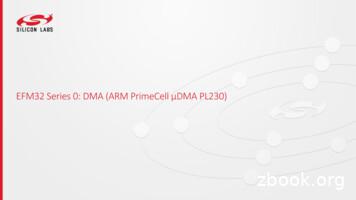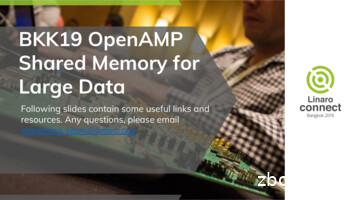Direct Memory Access (Dma):-
DIRECT MEMORY ACCESS (DMA):Programmed I/O and interrupt I/O provide data transfer between theMicroprocessor and external devices. However, there are variousinstances when data must be moved between memory and externaldevices.Fig ( 1) three devices connected to INT in a daisy chainFor example, amass storage device, such as a cassette recorder, one maywant to input or output programmed data to or from microcomputerRAM. Since the DMA performs data transfer memory and an externaldevice without involving the CPU,the interface or controller chip must beperform memory read and write operations in similar way asmicroprocessor.DMA controller chip typically provides by the following:1- the DMA controller chip puts the microprocessor in a hold state bymeans of the HOLD control signal. In this state the microprocessor stopsexecuting the program and disconnect the address, data2- the DMA controller chip takes over the microcomputer as soon as itreceives the DMA acknowledge signal from the microprocessor. It putsRAM location on the address and the appropriate control signal on thecontrol bus to transfer data between RAM and I/O device.
3- the DMA controller chip controls the RAM and an I/O device ittransfers control of the system bus to the microprocessor by removingthe microprocessor from the HOLD state.processor halt DMA:In this type of DMA, data transfer is performed between the memoryand peripheral device either by completely stopping the microprocessoruntil the transfer is completed or by technique called cycle stealing. Ineither case , the microprocessor is stopped for DMA operation. the firstmethod transfers acomplete block of data and is known as blocktransfer DMAThe decision of which type of DMA should used depends on the lengthof the data block. If the data block is large, block transfer DMA isrecommended. On the other hand, for small data blocks cycle stealingDMA is used. Also, if the microprocessor cannot be kept inactive in aparticle application for the time needed for the block transfer ,or cyclestealing DMA must be used. With either block transfer or cycle stealing.a DMA controller chip controls the DMA operation ,and is independentof the microprocessor.The DMA controller chip typically consist of:1. register:- containing the address of the data to be transferred to orfrom. The address register is incremented by 1 each time a byte istransferred . thus , data is transferred in a sequential order.2. counter:- containing the length of the data to be transferredand isdecremented by 1 each time a byte is transferred. When this counterreaches zero , the DMA transfer is completed.The address register and the counter are normally loaded by themicroprocessor.
We know describe the block transfer DMA and cycle stealingDMA:A. block transfer DMA:-this is the most common type of DMA used withmicroprocessors. As mentioned before in this type of DMA theperipheral device request the DMA transfer via DMA request line ,which is connected directly or through a DMA controller chip to themicroprocessor . the microprocessor completes the current instructionand sends a DMACK to the peripheral device in order to indicate that thebus can be used for DMA operation. The DMA controller chip thencompletes the DMA transfer and transfers the control of the bus to themicroprocessor.Fig ( 2) an 8085 interfaceB. cycle stealing DMA:-in this technique , the DMA controller transfers abyte of data between the memory and peripheral device by stealing aclock cycle of the microprocessor . the DMA controller will complete thetransfer by passing the microprocessor and generating proper signals tocomplete the transfer. Since the microprocessor is operated by anexternal clock, it is quite simple to stop the microprocessor momentarily.
This is accomplished by not providing the clock signal to themicroprocessor. An INHIBIT signal is used for this purpose, which isnormally HIGH and is logically AND with the system clock to generatethe microprocessor clock, as shown in Fig( 2).The DMA controller stops the microprocessor by lowering theINHIBIT signal to LOW. A timing diagram is shown in Fig ( 3). TheDMA controller then takes over the control of the microprocessorsystem bus for the time that microprocessor is stopped. Using cyclestealing, data is transferred 1 byte at a time.The DMA controller requests the microprocessor for each byte to betransferred.Fig ( 3):- cycle stealing DMAFig (4) cycle stealing DMA timing diagram
Interleaved DMA:Interleaved DMA is a more complex type of DMA operation using thistechnique , the DMA controller takes over the system bus when themicroprocessor is not using it. For example, the microprocessor doesn'tuse the bus when it performs internaloperations, such as decoding aninstruction or ALU operations. The DMA controller takes advantage ofthose times in order to transfer data, and this calledInterleaved DMA.One of the main characteristics of Interleaved DMA is that data transferoccurs without stopping the microprocessor. With Interleaved DMA,each data transfer includes 1 byte per instruction cycle.
completes the DMA transfer and transfers the control of the bus to the microprocessor. Fig ( 2) an 8085 interface B. cycle stealing DMA:-in this technique , the DMA controller transfers a byte of data between the memory and peripheral device by stealing a clock cycle of the microprocessor . the DMA controller will complete the
PG 3 DMA-011 DMA-043 DMA-096 DMA-053 DMA-056 DMA-064 DMA-063 DMA-066 DMA-066B DMA-067 DMA-068 DMA-079 DMA-084 DMA-087 DMA-088
Different DMA for each surface type. Slide courtesy of Santa Barbara County and Dan Cloak. 1225 SF Existing Impervious Area. DMA-1. 3200 DMA-2. 3200 DMA-3: 3700 DMA-4. 12400 DMA-5: 500 DMA-6. 8500 DMA-7: 4200 Total 35700 1225 SF Existing Impervious Area. Slide courtesy of Santa Barbara County and Dan Cloak. Sizing - Treatment Only. DMA Name .
This DMA General Certification Overview course is the first of five mandatory courses required for DMA certification: 1. DMA General Certification Overview 2. DMA Military Sexual Trauma (MST) and the Disability Examination Process 3. DMA Medical Opinions 4. DMA Aggravation Opinions 5. DMA Gulf War General Medical Examination
Thus Direct memory Access(DMA) technique is performed. Direct memory access (DMA) is a process in which an external device takes over the control of system bus from the CPU. Direct Memory Access (DMA) is a method whereby the memory and I/O space of the microprocessor can be accessed directly without the intervention of
DMA interrupt handler are implemented in emlib, but callbacks can be registered by application emlib DMA config includes DMA interrupt handler Callback functions registered during DMA config 17. Hands-on task 1 - Basic Mode 1. Open an\fae_training\iar\dma.eww and got to adc_basic project 2. Run code and check that DMA- CHREQSTATUS[0] is set to 1
Linux - DMA buf Application Coprocessor libmetal Allocator (ION ) Remoteproc ioctl to import DMA buf Linux Kernel metal_shm_open() metal_shm_attach() metal_shm_sync DMA buf DMA buf fd DMA buf fd va, dev_addr DMA buf fd dev addr, size Sync_r/Sync_w, Ack RPMsg dev_addr, size Sync_r/Sync_w, Shm size Ack
Direct Memory Access (DMA) is a scheme which uses a memory address generator and logic separate from the CPU to access memory. For instance, a DMA channel can move data from the ADC to data memory without CPU intervention. Experiments show that you can push at least four megabytes/sec through the PIC32 DMA subsystem and not affect CPU execution.
Service Level Agreement For any other Business Broadband Service, We’ll aim to restore the Service within 24 hours of you reporting the Fault. Where we need a site visit to resolve a Fault, we only do site visits on Working Days during Working Hours (please see definitions at the end of the document). Service Credits are granted at our discretion date by which Exclusions (applicable to all .























